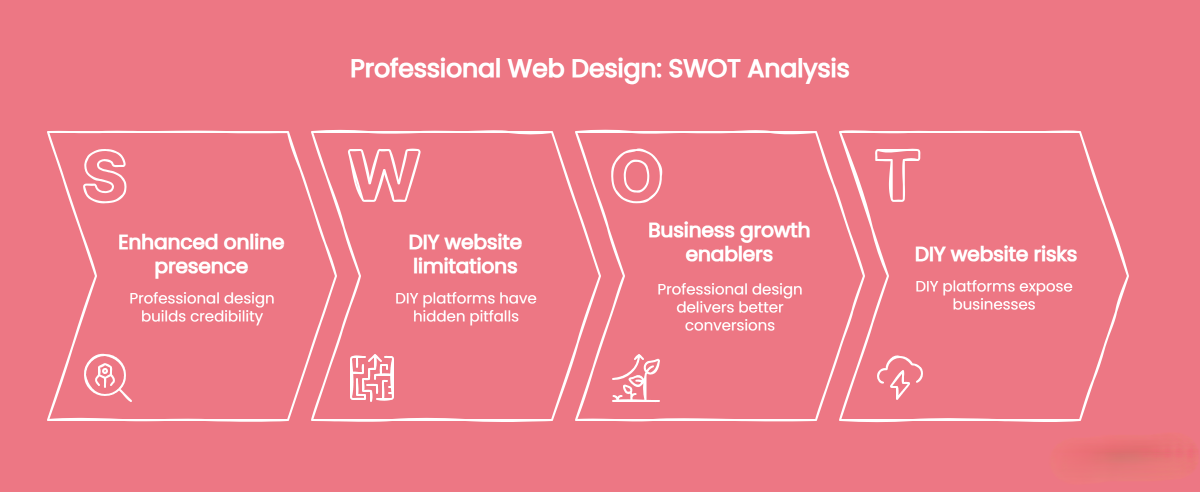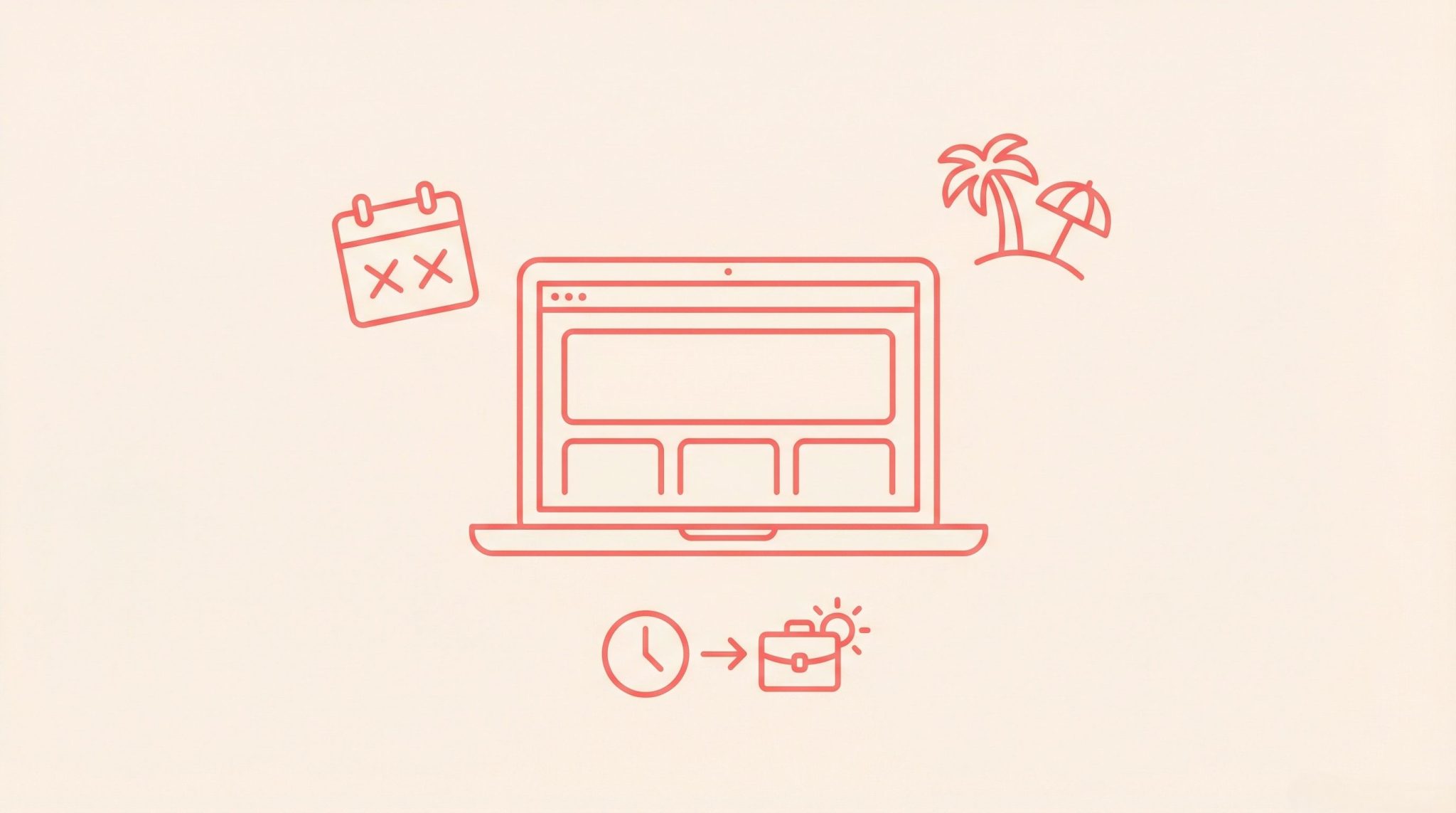TL;DR: DIY website builders may look appealing, but they leave Australian businesses exposed to five costly problems: poor mobile responsiveness (losing up to 60% of customers), technical SEO flaws that bury you on Google, user experience issues that drive buyers away, legal compliance risks under Australian law, and ongoing maintenance headaches. For most SMEs, investing $3,000–$10,000 in professional web design delivers better conversions, saves time, and protects your reputation.
A good website can win you customers. A bad one can quietly drive them away.
In Australia’s digital-first economy, your website is often the first impression—and sometimes the only one—you get. With DIY platforms like Wix and Squarespace promising fast, polished results, it’s easy to assume you can build a site yourself and move on.
But what these tools don’t show you are the hidden pitfalls: mobile experiences that frustrate users, SEO issues that bury your site on Google, and legal risks that could cost you thousands. These aren’t just technical oversights—they’re business risks.
This guide breaks down five critical problems that DIY builders can’t solve, and why investing in professional web design is often the smarter, safer, and more profitable choice for Australian businesses.

Problem 1: Poor mobile responsiveness that loses Australian customers
Why mobile experience matters in Australia
Over 21 million Australians browse the internet on mobile devices. That means your website’s mobile experience isn’t a secondary concern—it’s the first impression. With 94% of first impressions tied to design, a slow or broken layout can instantly turn visitors away.
DIY platforms like Wix and Squarespace offer basic mobile-friendly templates. But they often miss key details: touch-friendly navigation, device-specific breakpoints, and performance tuning. These gaps lead to frustrating experiences and longer load times.
What professional designers fix
Professional website designers go beyond surface-level responsiveness. They test your site across iOS, Android, and tablets to ensure every button, form, and menu works smoothly. Navigation is designed for thumbs, not mouse clicks. Load times are reduced from the DIY average of 8 seconds to under 3, improving both user experience and search rankings.
They also manage breakpoints beyond the standard desktop, tablet, and mobile presets. This means your site adapts intelligently to different screen sizes and orientations, keeping users engaged no matter what device they’re using.
Real cost of DIY mobile mistakes
Poor mobile responsiveness doesn’t just frustrate users—it costs you business. Up to 60% of potential customers won’t return after a bad mobile experience. That bounce rate sends negative signals to Google, which can hurt your search rankings.
What seems like a quick DIY fix can quietly erode your brand, reduce conversions, and make your site harder to find.
Problem 2: Technical SEO disasters that kill your Google rankings
Why technical SEO matters more than you think
You’ve probably heard that content is king. But here’s what they don’t tell you: technical SEO is the throne.
Website builders generate bloated code that slows your site to a crawl. While you’re focused on keywords, Google’s algorithms are penalising you for poor Core Web Vitals—metrics that DIY platforms consistently fail.
Professional web development means clean, semantic HTML that search engines love. It means proper structured data implementation that helps Google understand your business. It’s the difference between page 10 and page 1.
XML sitemaps, schema markup, canonical URLs—these aren’t just buzzwords. They’re the foundation of an SEO-friendly website design that actually ranks.
Local SEO and Australian search behaviour
Australian searchers have unique behaviours that template sites can’t address.
When someone searches for “plumber near me” in Brisbane, Google needs specific signals to show your business. Professional designers integrate your Google Business Profile seamlessly, implement location-specific optimisation for Australian cities, and add schema markup that tells search engines you’re a legitimate Australian business.
This local SEO expertise is why searches for “web design Melbourne,” “web design Sydney,” or “web design Brisbane” return professional agencies, not DIY template users.
Without proper local optimisation, you’re invisible to the 46% of Google searches with local intent.
What you can’t learn from YouTube tutorials
Sure, you can watch a dozen YouTube videos about SEO. But can you conduct a technical SEO audit? Configure server-side rendering? Implement proper SSL certificates?
Professional designers understand Australian hosting requirements versus overseas options. They know that hosting with Australian providers can improve load times by 200ms—crucial for user experience and rankings.
These technical details form the backbone of a website that ranks on Google, not just exists on it.
Problem 3: User experience nightmares that drive visitors away
Why professional UX design converts more customers
User experience design isn’t about making things pretty—it’s about psychology and profit.
Professional designers understand conversion rate optimisation (CRO) at a scientific level. They map user journeys, identifying friction points that cost you sales. They apply psychological principles that guide visitors toward your goals.
A/B testing capabilities allow professionals to test variations and prove what works. This data-driven approach to website conversion optimisation can double or triple your conversion rates.
Meanwhile, DIY builders leave you guessing why visitors aren’t buying.
What DIY templates get wrong
Ever notice how Wix sites all look… well, like Wix sites?
Template limitations go beyond surface-level aesthetics. You’re stuck with generic layouts identical to your competitors. Navigation structures that can’t adapt to your unique business model. Forms that frustrate rather than convert.
Custom website design breaks these chains. It creates unique experiences tailored to your specific audience, not a one-size-fits-all approach that fits nobody well.
Your inflexible template could be why visitors choose competitors with professional, custom-built sites.
Australian consumer expectations
Australian buyers have specific trust requirements that templates can’t address.
They look for local payment gateways like Afterpay, not just PayPal. They expect to see your ABN displayed properly. They need reassurance that you comply with Australian Consumer Law.
Professional designers integrate these trust signals naturally. They understand that Australians prefer clear pricing in AUD, local phone numbers, and familiar payment methods.
These details build credibility that converts browsers into buyers.
Problem 4: Legal compliance issues that expose you to risk
Why accessibility compliance matters in Australia
Here’s a sobering fact: Your website must comply with the Disability Discrimination Act 1992.
This isn’t optional. Australian businesses face legal action for inaccessible websites. WCAG 2.1 compliance means screen reader compatibility, keyboard navigation, and proper colour contrast ratios.
Professional accessible website design in Australia ensures you meet these requirements. DIY builders? They offer basic accessibility features that won’t hold up in court.
The cost of remediation after a discrimination complaint far exceeds any web design investment.
Privacy and data protection requirements
The Australian Privacy Principles (APPs) aren’t suggestions—they’re law.
Your website needs proper cookie consent mechanisms, secure data storage, and clear privacy policies. If you serve international visitors, GDPR compliance adds another layer of complexity.
Professional developers implement these requirements properly. They ensure your website security in Australia meets legal standards, protecting both you and your customers.
DIY mistakes here don’t just cost money—they can destroy your reputation.
Why DIY platforms fall short
Template builders offer limited accessibility features that barely meet minimum standards.
Without legal knowledge, you’re guessing at compliance requirements. One discrimination lawsuit could cost tens of thousands in legal fees and damages.
Professional designers understand these risks. They build compliance into your site’s foundation, not as an afterthought. They document accessibility features and provide ongoing updates as regulations change.
This protection alone justifies professional web design investment.
Problem 5: Ongoing maintenance nightmares and hidden costs
The real cost of DIY website ownership
That “$20/month” website builder? Let’s talk real numbers.
You’ll spend 10-15 hours monthly on updates and fixes—time worth $500-$1,500 if you value your time at business rates. Plugin conflicts crash your site during peak shopping periods. Platform updates break custom code you spent weeks perfecting.
Limited scalability means rebuilding from scratch when you outgrow the platform. These website maintenance costs in Australia quickly exceed professional design fees.
Suddenly, that DIY “bargain” looks expensive.
What professional designers provide beyond the initial build
Professional relationships don’t end at launch.
Quality designers offer ongoing support and maintenance packages. They provide content management system (CMS) training so you can make updates confidently. Security monitoring prevents breaches before they happen.
WordPress maintenance in Australia typically includes performance optimisation, keeping your site fast as it grows. Backup and disaster recovery mean you’re never one hack away from losing everything.
This ongoing partnership ensures your investment continues delivering returns.
Breaking down the Australian website running costs
Let’s get specific about what you’re really paying:
- Domain registration: $10-$50/year (.com.au domains)
- Quality hosting: $50-$200/month (not the cheap stuff that crashes)
- SSL certificates: $0-$200/year
- Premium plugins/themes: $200-$1,000/year
- Monthly maintenance: $100-$500/month (if outsourced)
Professional designers often bundle these services, providing better value than piecing together DIY solutions.
They also know which Australian hosts provide best performance for local audiences—knowledge that saves money long-term.
When you might not need a professional web designer
Situations where DIY website builders make sense
Let’s be honest: not everyone needs professional web design immediately.
Personal blogs, hobby sites, and learning projects are perfect for DIY website builders in Australia. Very early-stage startups might use templates while validating their business model.
Simple portfolio websites or temporary landing pages don’t justify professional investment. If you’re testing an idea with zero budget, templates get you started.
But understand these are stepping stones, not destinations.
Hybrid approach: Starting DIY, upgrading later
Many successful businesses start with templates then upgrade.
The key? Protect your brand during transition. Choose a platform that allows easy migration to custom solutions. Document what works and what doesn’t in your current setup.
Professional designers can migrate you from Wix to a custom website, preserving your SEO value and customer base. This phased approach spreads costs while building toward professional presence.
Just don’t wait too long—the migration gets harder as you grow.
Making the decision: Is professional web design worth it for your Australian business
Calculating the ROI of professional web design
Numbers don’t lie. Here’s your website design ROI breakdown:
A 2% conversion rate improvement on $100,000 annual revenue equals $2,000—nearly covering your investment. Time saved from DIY frustration: 20 hours monthly at $50/hour = $12,000 yearly.
Avoiding one accessibility lawsuit: priceless (but actually $20,000-$50,000 in legal fees).
The competitive advantage in your industry? When competitors use templates while you have custom design, you win by default.
Making the move toward professional design
If your website is holding back your business, now is the time to act. Start by reviewing your current site and identifying what’s working—and what’s not. Look at competitors with strong online presence and take note of what they do differently.
Define clear goals for your website. Whether it’s improving conversions, boosting search visibility, or building trust with customers, those goals will guide your next steps.
Then, research Australian web designers or agencies with proven experience. Ask for proposals that show how they’ll solve your specific challenges, not just how the site will look.
The sooner you move toward professional design, the sooner your website starts working for your business—not against it.
Frequently Asked Questions
How much should I budget for professional web design in Australia?
Most Australian SMEs should budget $3,000-$10,000 for professional web design. E-commerce sites typically cost $5,000-$15,000, while complex custom web applications can exceed $20,000. Remember to factor in ongoing maintenance costs of $100-$500 monthly.
Can I build a professional website myself using Wix or Squarespace?
While DIY builders work for simple sites, they can’t match professional web development for conversion optimisation, technical SEO, accessibility compliance, and custom functionality. Most businesses eventually outgrow these platforms, making professional design inevitable.
How long does professional web design take compared to DIY?
Professional web design typically takes 4-12 weeks but delivers a complete, optimised solution. DIY might seem faster initially, but ongoing tweaks, fixes, and learning curves often extend the timeline to months—with inferior results.
What’s the difference between a web designer and web developer?
Web designers focus on visual design, user experience, and branding. Web developers handle coding, functionality, and technical implementation. Many Australian agencies offer both services, ensuring cohesive design and development.
Do I need ongoing maintenance after my website is built?
Yes. Websites require regular updates, security patches, and performance optimisation. Professional maintenance packages ($100-$500/month) ensure your site stays secure, fast, and functional without consuming your time.





